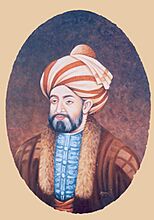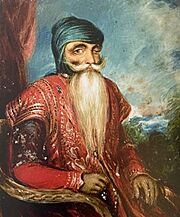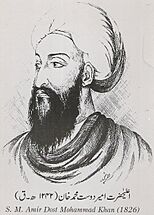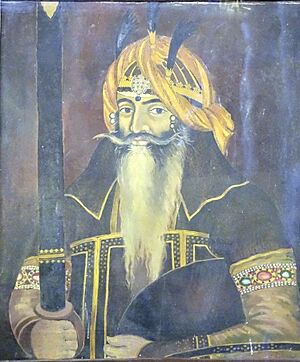Afghan–Sikh wars facts for kids
Quick facts for kids Afghan–Sikh wars |
|||||||
|---|---|---|---|---|---|---|---|
|
|||||||
| Belligerents | |||||||
Supported by: Principality of Qandahar Peshawar Sardars |
|||||||
| Commanders and leaders | |||||||
Fateh Khan Barakzai Nawab Muzaffar Khan † Dela Khan † |
|||||||
The Afghan–Sikh wars were a series of conflicts that happened between 1748 and 1837 in the Indian subcontinent. These wars involved the Durrani Empire and the Sikh Empire (and the Sikh groups before it). Most of the fighting took place in and around the Punjab region. The conflicts started when the Dal Khalsa, an army of Sikh groups, was active. The fighting continued even after the Emirate of Kabul took over from the Durrani Empire.
Contents
Why the Wars Started
The Sikh Confederacy became independent from the Mughal Empire around 1716. Over the next few decades, the Sikhs grew stronger, even after a tough period called the Chhota Ghallughara.
A powerful Persian ruler named Nader Shah invaded the Mughal Empire between 1738 and 1740. This greatly weakened the Mughals. After Nader Shah died in 1747, Ahmed Shah Abdali created his own new Afghan state, the Durrani Empire. Four years later, this new Afghan state began fighting with the Sikh groups.
Ahmad Shah Abdali's Campaigns
On January 12, 1748, Ahmad Shah Durrani invaded and took over Lahore. The Mughal governor of Lahore had already run away to Delhi. Ahmad Shah put his own governor in charge of Lahore and moved his army further east. However, he was defeated at the Battle of Manupur by the Mughals, who were allied with the Sikhs. Ahmad Shah then fled back to Kandahar.
Sikh groups led by Charat Singh, Jassa Singh Ahluwalia, and Ala Singh kept bothering the Durrani forces as they retreated. This first invasion by Ahmad Shah failed. But it helped the Sikhs organize themselves into the Dal Khalsa, their main army, in March 1748. The Sikhs took Lahore back, but lost it again to the Afghans by April 12, 1752.
The Sikhs used guerilla warfare (surprise attacks and quick retreats) to try and push the Afghans out of Punjab. In November 1757, the Afghan army, led by Timur Shah Durrani, Ahmad Shah's son, defeated the Sikhs at the Battle of Amritsar. After this, the Durrani commander Jahan Khan and Timur Shah fled Lahore. As they tried to cross the Chenab and Ravi rivers, many Afghan soldiers drowned, and they lost a lot of their supplies.
The Sikhs took captured Afghan soldiers to Amritsar to clean the sacred pool that the Afghans had damaged. In 1758, the Sikhs defeated the Afghan military officer Sa‘adat Khan Afridi, who fled from Jalandhar. The Afghans were then defeated from all sides. The Sikhs captured Lahore and took its wealth, but the Afghans recaptured it in 1761. However, just a couple of months later, in May 1761, the Sikh army defeated the Afghan army again. After this, the Sikhs captured Lahore once more.
By September 1761, the Sikhs had defeated Ahmad Shah Durrani's governor of Lahore. They continued to defeat and remove the remaining Afghan commanders. This led to the Sikhs taking control of all the lands from the Satluj to the Indus rivers. Ahmad Shah lost most of Punjab to the Sikhs.
In October 1762, Ahmad Shah Durrani attacked Amritsar but was defeated by the Sikhs. In November 1763, Sikh forces pushed the Durrani armies to advance, leading to the Battle of Sialkot. The Afghans were defeated there and had to stop their campaign in Punjab. At Gujranwala, Jahan Khan was heavily defeated by the Sikhs. The Sikhs then continued their victories by attacking the towns of Malerkotla and Morinda. They also defeated and captured Sarbaland Khan Saddozai, the commander of Rohtas Fortress. He was later released after agreeing to Sikh rule.
Ahmad Shah was very angry about these defeats. He asked Nasir Khan, the ruler of Kalat, to join him in a holy war against the Sikhs. He wanted to destroy them and capture their women and children. But Ahmad Shah's march to Punjab in 1764 failed. His advance troops were defeated and pushed back by the Sikhs outside Lahore. In 1765, Ahmad Shah marched to Punjab again, but his power was limited to his camp. The Sikhs surrounded his camp, and he had to stay on the defensive. Eventually, Ahmad Shah returned to Kabul without fighting a single major battle. A historian with him noted that the land from Sirhind to Derajat was now controlled by the Sikhs. The Sikhs showed their control in Lahore by making coins with the same message that Banda Singh Bahadur had used 55 years earlier. This re-established Sikh rule.
The Sikhs also captured Multan in 1772. The time from 1772 to 1780 was known as the "Sikh Interlude Period."
Timur Shah's Campaigns
Timur Shah Durrani became the ruler of the Durrani Empire after his father, Ahmad Shah Durrani, died. Timur Shah worked to strengthen his rule. He tried a campaign in 1775, but his army was too small, so he went back to Peshawar.
In late 1779, Timur Shah decided to conquer Multan. The Sikhs controlled the provinces of Lahore and Multan, which blocked Timur Shah's attempts to invade. Many local leaders who were supposed to be loyal to the Durranis were not respecting Timur Shah's rule. For example, Sindh paid less tribute, and Nasir Khan Balouch, the ruler of Kalat, did not recognize Timur Shah's authority.
Timur Shah tried to get Multan back peacefully. He sent an agent, Haji Ali Khan, to talk to the Bhangi Sikh Chiefs. But Haji Ali Khan threatened them instead. The Bhangis tied Haji to a tree and killed him. They sent his companions back to report to Timur Shah.
When Timur Shah heard about this, he sent an army of 18,000 men under General Zangi Khan. Zangi Khan's orders were to march secretly and surprise the Sikhs. Early one morning, the Sikhs were completely unaware when they were attacked. Even though they were not organized, the Sikhs fought hard but were eventually defeated. About 3,000 Sikhs were killed, and 500 drowned trying to cross the Jhelum river. Another 2,000 escaped.
After this victory, Timur Shah Durrani captured Multan. A fierce battle was fought on February 8, 1780, in Shujabad against a Sikh force trying to help Multan. The Sikhs lost 2,000 men and fled towards Lahore. Timur Shah sent a large army after them, catching them at Hujra Muqim Khan, southwest of Lahore. Timur Shah then went to Multan and ordered a general killing in the city. He then surrounded the fort where the Sikh army was. After talks, Timur Shah took over the fort on February 18, 1780. He appointed Muzaffar Khan as the governor of Multan. Multan remained under Afghan rule until the Sikh Empire captured it in 1818 during the Siege of Multan.
This period of conflict ended when Timur Shah died on May 20, 1793. His son, Zaman Shah Durrani, then became the ruler.
Zaman Shah's Campaigns
Zaman Shah Durrani became the ruler of the Durrani Empire after his father, Timur Shah, died in 1793. Zaman Shah led several campaigns into Punjab against the Sikhs. His first campaign began in November 1796.
First Campaign in Punjab
Zaman Shah's campaign in Punjab in 1796 led to him capturing Lahore in January 1797. The Sikh chiefs did not fight him there; they went to Amritsar to protect their holy city. Zaman Shah moved towards Amritsar on January 13, 1797, but the Sikhs defeated him about 10 km away from the city.
Zaman Shah had to leave his campaign and return home quickly. He had received news from Kabul that his own brother, Mahmud Shah Durrani, might invade Afghanistan. The Sikhs recaptured Lahore as he left. He left his deputy general, Ahmad Khan Shahanchi-bashi, in charge with Afghan soldiers. But the Sikhs also defeated and killed him.
Second Campaign in Punjab
After dealing with his brother for a while, Zaman Shah returned to Punjab. He started his campaign again, taking over Lahore in the autumn of 1798 without a fight. This was part of Ranjit Singh's plan to let the Afghans enter Lahore and then surround them.
Zaman Shah wanted to march on Delhi. But the Sikhs destroyed supplies for about 150 km around his camp to stop his army from getting food. They also fought small battles with his troops. Facing a determined enemy who could cut off his supplies from Kabul, Zaman Shah decided to return to Afghanistan with his troops on January 4, 1799. The Bhangi Sikh Misl (a group of Sikhs) recaptured Lahore.
Zaman Shah then made 19-year-old Ranjit Singh the governor of Lahore. He hoped this would divide the Sikhs. Zaman Shah returned to Peshawar, with the Sikhs bothering the Afghans all the way to the Jhelum river. While crossing the river, Zaman Shah lost many men, supplies, and heavy cannons because of a sudden flood. Finally, Shah Zaman and his remaining army reached Kandahar in late 1799, tired from the campaign.
Third Campaign in Punjab
Zaman Shah started his third campaign in Punjab in the spring of 1800. He planned to deal with the rebellious Ranjit Singh. However, he had problems back home in Afghanistan and had to deal with his brother, Mahmud Shah Durrani, again. Shah Zaman never returned to Punjab, and Mahmud Shah later removed him from power.
Maharaja Ranjit Singh's Campaigns
In 1813, the Durrani prime minister, Wazir Fateh Khan, surrounded the fort at Attock. This happened after he demanded the fort be returned. A Sikh relief force arrived, and for three months, the two armies faced each other without moving. As the summer heat became intense, Dewan Mokham Chand moved his army to stop the Afghans from getting water from the river.
Without water, the Afghan troops started to suffer from dehydration. They launched many attacks towards the river but could not break through. Chand realized the Afghans were weak. He charged his cavalry (soldiers on horseback) at the Afghans, who broke ranks and ran, losing 2,000 men.
Fateh Khan accused Ranjit Singh of betrayal. In April 1813, he left Kashmir with 15,000 cavalry and surrounded Attock Fort. At the same time, Ranjit Singh sent Dewan Mokham Chand and Karam Chand Chahal from Burhan. They had cavalry, artillery (cannons), and infantry (foot soldiers) to meet the Afghans.
Dewan Mokham Chand Nayyar set up his camp about 8 km from the Afghan camp. He did not want to risk a big battle, though both sides had many small fights and suffered losses. On July 12, 1813, the Afghans ran out of supplies. Dewan Mokham Chand Nayyar marched 8 km from Attock to Haidaru, by the Indus River, to offer battle.
On July 13, 1813, Dewan Mokham Chand Nayyar divided his cavalry into four groups. He gave one group to Hari Singh Nalwa and commanded one himself. The single group of infantry formed a square to protect the artillery, with Gouse Khan in charge of the cannons. The Afghans took positions opposite the Sikhs, with some of their cavalry led by Dost Mohammad Khan.
Fateh Khan started the battle by sending his Pathans in a cavalry charge. But heavy fire from the Sikh artillery pushed them back. The Afghans regrouped under Dost Mohammad Khan. He led another cavalry charge that broke one part of the Sikh army and captured some cannons. When it looked like the Sikhs might lose, Dewan Mokham Chand led a cavalry charge while riding a war elephant. This pushed the Afghans back "at all points" and made the remaining Afghan troops run away. Fateh Khan, fearing his brother Dost Mohammad Khan had died, escaped to Kabul. The Sikhs captured the Afghan camp, including the cannons they had lost.
Two months after winning at Attock, Ranjit Singh decided to take advantage of the problems in the Durrani Kingdom. He launched a campaign to take Kashmir from the Durrani Empire. Starting late in autumn meant the campaign had to wait until the next spring. By June, an army of 30,000 men under Ram Dyal, Dewan Mokham Chand's grandson, marched towards Baramulla. Another attack of 20,000 men led by Ranjit Singh marched to Poonch.
Ranjit's force was delayed by heavy rains. Ram Dyal's army took the fortress of Baramulla on July 20, 1814. When Dyal's army reached Shupaiyan, the governor of Kashmir, Azim Khan, blocked their advance. Dyal fought to delay the Afghans and waited for 5,000 more men from Ranjit. But Afghan snipers stopped these reinforcements.
Ranjit Singh's force made little progress. The people fleeing burned their crops, causing a big food shortage for his army. Then, a cholera outbreak happened. Meanwhile, Ram Dyal, who was dug in near Srinagar, received an offer from Azim Khan for peace talks. He was able to get his army out of a tough spot. Ranjit Singh's campaign ended in failure.
After the victory at Attock, Amritsar, Lahore, and other big cities in the Sikh Empire were lit up for two months to celebrate. After his defeat at Attock, Fateh Khan fought off an attempt by Ali Shah, the ruler of Persia, and his son Ali Mirza to capture the Durrani province of Herat. This left their newly captured province of Kashmir open to attack.
Siege of Multan
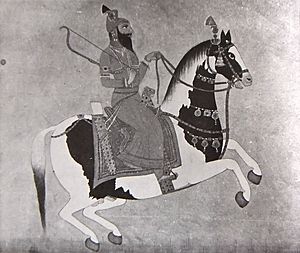
In early January, the Sikh army began their campaign by capturing Nawab Muzaffar Khan's forts at Muzaffargarh and Khangarh. In February, the Sikh force under Kharak Singh reached Multan. They ordered Muzaffar to pay the large amount of money he owed and to give up the fort. But Muzaffar refused.
The Sikh forces won a battle near the city but could not capture Muzaffar before he went back into the fort. The Sikh army asked for more cannons. Ranjit Singh sent them the Zamzama (a very large cannon) and other big artillery pieces. These cannons began firing at the fort walls. In early June, Sadhu Singh and a small group of other Akalis attacked the fort walls. They found a break in the wall. As they ran in to fight the surprised soldiers inside, the larger Sikh army was alerted and entered the fort through the opening. Muzaffar and his sons tried to fight their way out to defend the fort but were killed in the battle.
The siege of Multan ended much of the Afghan influence in the Peshawar region. It led to several Sikh attempts to capture Peshawar, and they eventually succeeded.
Battle of Shopian
This battle took place in the Shopian area of Kashmir. It was part of the 1819 Kashmir expedition, which resulted in Kashmir becoming part of the Sikh Empire.
When the Sikh army entered the city of Srinagar after the battle, Prince Kharak Singh promised that every citizen would be safe. He made sure the city was not robbed. The peaceful capture of Srinagar was important because Srinagar was a major center for making Shawls. It was also a key trading hub between Panjab, Tibet, Iskardo, and Ladakh.
After taking Srinagar, the Sikh army faced no major resistance in conquering Kashmir. Ranjit Singh appointed Moti Ram, the son of Dewan Mokham Chand, as the new governor of Kashmir. He also sent a "large body of troops" with him. These troops were to make sure that strongholds within Kashmir that might try to resist Sikh rule would pay their taxes. The capture of Kashmir set the boundaries of the Sikh Empire with Tibet. The conquest of Kashmir was a "huge addition" to the Sikh Empire. It "significantly" increased the empire's income and land area.
Battle of Nowshera
The bloody Battle of Nowshera happened on March 14, 1823. In this battle, Ranjit Singh led the Sikh forces to defeat the Yusufzai Afghans, who were supported by the Peshawar leaders. Azim Khan Barakzai died shortly after the battle from Cholera.
Battle of Jamrud
The Battle of Jamrud was the fifth and most important battle in the third Afghan–Sikh war. The outcome of this battle is debated by historians. Some say that the Afghans failed to take the fort and the city of Peshawar or the town of Jamrud, which means it was a Sikh victory. Others say that the killing of Hari Singh Nalwa meant it was an Afghan victory. James Norris, a professor, says that the battle's outcome was not clear.
See Also
- List of battles between Mughals and Sikhs
- List of battles involving the Sikh Empire
- Hill States–Sikh wars
- Pashtun tribes
- Nepal–Sikh war
- Sino-Sikh war
- First Anglo-Sikh war
- Second Anglo-Sikh war
Images for kids
Sources


